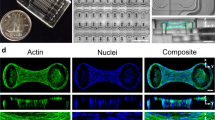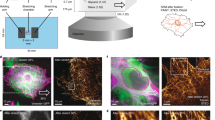Abstract
Observations from diverse studies on cell biomechanics and mechanobiology reveal that altered mechanical stimuli can induce significant changes in cytoskeletal organization, focal adhesion complexes, and overall mechanical properties. To investigate effects of short-term equibiaxial stretching on the transverse stiffness of and remodeling of focal adhesions in vascular smooth muscle cells, we developed a cell-stretching device that can be combined with both atomic force and confocal microscopy. Results demonstrate that cyclic 10%, but not 5%, equibiaxial stretching at 0.25 Hz significantly and rapidly alters both cell stiffness and focal adhesion associated paxillin and vinculin. Moreover, measured changes in stiffness and focal adhesion area from baseline values tend to correlate well over the durations of stretching studied. It is suggested that remodeling of focal adhesions plays a critical role in regulating cell stiffness by recruiting and anchoring actin filaments, and that cells rapidly remodel in an attempt to maintain a homeostatic biomechanical state when perturbed above a threshold value.








Similar content being viewed by others
References
Balaban, N. Q., Schwarz, U. S., Riveline, D., Goichberg, P., Tzur, G., Sabanay, I., Mahalu, D., Safran, S., Bershadsky, A., Addadi, L., Geiger, B., 2001. Force and focal adhesion assembly: a close relationship studied using elastic micropatterned substrates. Nat. Cell Biol. 3, 466–473.
Beatty, M. F., Usmani, S. A., 1975. On the indentation of a highly elastic half-space. Q. J. Mech. Appl. Math. 28, 47–62.
Chiquet, M., 1999. Regulation of extracellular matrix gene expression by mechanical stress. Matrix Biol. 18, 417–426.
Costa, K. D., Hucker, W. J., Yin, F. C.-P., 2002. Buckling of actin stress fibers: a new wrinkle in the cytoskeletal tapestry. Cell Motil. Cytoskeleton 52, 266–274.
Costa, K. D., Yin, F. C.-P., 1999. Analysis of indentation: implications for measuring mechanical properties with atomic force microscopy. ASME J. Biomech. Eng. 121, 462–471.
Crick, S. L., Yin, F. C.-P., 2007. Assessing micromechanical properties of cells with atomic force microscopy: importance of the contact point. Biomech. Model Mechanobiol. 6, 199–210.
Cukierman, E., Pankov, R., Stevens, D. R., Yamada, K. M., 2001. Taking cell-matrix adhesions to the third dimension. Science 294, 1708–1712.
Cunningham, J. J., Linderman, J. J., Mooney, D. J., 2002. Externally applied cyclic strain regulates localization of focal contact components in cultured smooth muscle cells. Ann. Biomed. Eng. 30, 927–935.
Deguchi, S., Ohashi, T., Sato, M. 2006. Tensile properties of single stress fibers isolated from cultured vascular smooth muscle cells. J. Biomech. 39, 2603–2611.
Deng, L., Fairbank, N. J., Fabry, B., Smith, P. G., Maksym, G. N., 2004. Localized mechanical stress induces time-dependent actin cytoskeletal remodeling and stiffening in cultured airway smooth muscle cells. Am J Physiol Cell Physiol 287, C440–C448.
Goffin, J. M., Pittet, P., Csucs, G., Lussi, J. W., Meister, J.-J., Hinz, B., 2006. Focal adhesion size controls tension-independent recruitment of α-smooth muscle actin to stress fibers. J. Cell Biol. 172, 259–268.
Goldschmidt, M. E., McLeod, K. J., Taylor, W. R., 2001. Integrin-mediated mehano-transduction in vascular smooth muscle cells: frequency and force response characteristics. Circ. Res. 88, 674–680.
Grinnell, F., 2003. Fibroblast biology in three-dimensional collagen matrices. Trends Cell Biol. 13, 264–269.
Hayakawa, K., Sato, N., Obinata, T., 2001. Dynamic reorientation of cultured cells and stress fibers under mechanical stress from periodic stretching. Exp. Cell Res. 268, 104–114.
Hinz, B., 2006. Masters and servants of the force: the role of matrix adhesions in myofibroblasts force perception and transmission. Eur. J. Cell Biol. 85, 175–181.
Hu, K., Applegate, K. T., Danuser, G., Waterman-Storer, C. M., 2007. Differential transmission of actin motion within focal adhesion. Science 315, 111–115.
Huang, H., Kamm, R. D., Lee, R. T., 2004. Cell mechanics and mechanotransduction: pathways, probes, and physiology. Am. J. Physiol. Cell Physiol. 287, C1–C11.
Huang, H., Sylvan, J., Jonas, M., Barresi, R., So, P. T. C., Campbell, K. P., Lee, R. T., 2005. Cell stiffness and receptors: evidence for cytoskeletal subnetworks. Am. J. Physiol. Cell Physiol. 288, C72–C80.
Humphrey, J. D. Vascular adaptation and mechanical homeostasis at tissue, cellular, and sub-cellular levels. Cell Biochem. Biophys., 2008 (in press).
Humphrey, J. D., Vawter, D. L., Vito, R. P., 1987. Quantification of strains in biaxially tested soft tissues. J. Biomech. 20, 59–65.
Ingber, D. E., 2002. Mechanical signaling and the cellular response to extracellular matrix in angiogenesis and cardiovascular physiology. Circ. Res. 91, 877–887.
Kim, B. S., Nikolovski, J., Bonadio, J., Mooney, D. J., 1999. Cyclic mechanical strain regulates the development of engineered smooth muscle tissue. Nat. Biotechnol. 17, 979–983.
Kumar, S., Maxwell, I. Z., Heisterkamp, A., Polte, T. R., Lele, T. P., Salanga, M., Mazur, E., Ingber, D. E., 2006. Viscoelastic retraction of single living stress fibers and its impact on cell shape, cytoskeletal organization, and extracellular matrix mechanics. Biophys. J. 90, 3762–3773.
Li, C., Xu, Q., 2000. Mechanical stress-initiated signal transductions in vascular smooth muscle cells. Cell. Signal. 12, 435–445.
Mizutani, T., Haga, H., Kawabata, K., 2004. Cellular stiffness response to external deformation: tensional homeostasis in a single fibroblast. Cell Motil. Cytoskeleton 59, 242–248.
Pender, N., McCulloch, C. A. G., 1991. Quantitation of actin polymerization in two human fibroblast sub-types responding to mechanical stretching. J. Cell Sci. 100, 187–193.
Pourati J., Maniotis A., Spiegel D., Schaffer J. L., Butler J. P., Fredberg J. J., Ingber D. E., Stamenovic D., Wang N. 1998. Is cytoskeletal tension a major determinant of cell deformability in adherent endothelial cells? Am. J. Physiol. 274, C1283–1289.
Reusch, P., Wagdy, H., Reusch, R., Wilson, E., Ives, H. E., 1996. Mechanical strain increases smooth muscle and decreases nonmuscle myosin expression in rat vascular smooth muscle cells. Circ. Res. 79, 1046–1053.
Rico, F., Roca-Cusachs, P., Gavara, N., Farre, R., Rotger, M., Navajas, D., 2005. Probing mechanical properties of living cells by atomic force microscopy with blunted pyramidal cantilever tips. Phys. Rev. E 72, 021914-1–021914-10.
Romer, L. H., Birukov K. G., Garcia J. G. N., 2006. Focal adhesions: paradigm for a signaling nexus. Circ. Res. 98, 606–616.
Saez A. O., Zhang W., Wu Y., Turner C. E., Tang D. D., Gunst S. J. 2004. Tension development during contractile stimulation of smooth muscle requires recruitment of paxillin and vinculin to the membrane. Am. J. Physiol. Cell Physiol. 286, C433–C447.
Sawada, Y., Sheetz, M. P., 2002. Force transduction by triton cytoskeleton. J. Cell Biol. 156, 609–615.
Smith, P. G., Deng, L., Fredberg, J. J., Maksym, G. N., 2003. Mechanical strain increases cell stiffness through cytoskeletal filament reorganization. Am. J. Physiol. Lung Cell. Mol. Physiol. 285, L456–L463.
Smith, P. G., Garcia, R., Kogerman, L., 1997. Strain reorganizes focal adhesions and cytoskeleton in cultured airway smooth muscle cells. Exp. Cell Res. 232, 127–136.
Smith, B. A., Tolloczko, B., Martin, J. G., Grutter, P., 2005. Probing the viscoelastic behavior of cultured airway smooth muscle cells with atomic force microscopy: stiffening induced by contractile agonist. Biophys. J. 88, 2994–3007.
Sumpio B. E., Banes A. J., Levin L. G., Johnson G. Jr., 1987. Mechanical stress stimulates aortic endothelial cells to proliferate. J. Vasc. Surg. 6, 252–256.
Takemasa, T., Yamaguchi, T., Yamamoto, Y., Sutimoto, K., Yamashita, K., 1998. Oblique alignment of stress fibers in cells reduces the mechanical stress in cyclically deforming fields. Eur. J. Cell Biol. 77, 91–99.
Tan, J. L., Tien, J., Pirone, D. M., Gray, D. S., Bhadriraju, K., Chen, C. S., 2003. Cells lying on a bed of microneedles: an approach to isolate mechanical force. Proc. Natl. Acad. Sci. 100, 1484–1489.
Theriot, J. A., 1994. Regulation of the actin cytoskeleton in living cells. Semin. Cell Biol., 5, 193–199.
Tomasek, J. J., Gabbiani, G., Hinz, B., Chaponnier, C., Brown, R. A., 2002. Myofibroblasts and mechanoregulation of connective tissue remodeling. Nat. Rev. Mol. Cell Biol. 3, 349–363.
Trache, A., Meininger, G. A., 2005. Atomic force-multi-optical imaging integrated microscope for monitoring molecular dynamics in live cells. J. Biomed. Optics 10, 064023-1–064023-17.
Trache A., Trzeciakowski J. P., Gardiner L., Sun Z., Muthuchamy M., Guo M., Yuan S. Y., Meininger G. A. 2005. Histamine effects on endothelial cell fibronectin interaction studied by atomic force microscopy. Biophys. J. 89, 2888–2898.
Trzeciakowski, J., and G. A. Meininger. Software for analysis of atomic force data, 2004. Copyright.
Vliet, K. J. V., Bao, G., Suresh, S., 2003. The biomechanics toolbox: experimental approaches for living cells and biomolecules. Acta Mater. 51, 5881–5905.
Wang, J. H.-C., Goldschmidt-Clermont, P., Moldovan, N., Yin, F. C.-P., 2000. Leukotrienes and tyrosine phosphorylation mediate stretching-induced actin cytoskeletal remodeling in endothelial cells. Cell Motil. Cytoskeleton 46, 137–145.
Wang, J. H.-C., Goldschmidt-Clermont, P., Wille, J., Yin, F. C.-P., 2001. Specificity of endothelial cell reorientation in response to cyclic mechanical stretching. J. Biomech. 34, 1563–1572.
Wang, N., Tolic-Norrelykke I. M., Chen, J., Mijailovich, S. M., Butler, J. P., Fredberg, J. J., Stamenovic, D., 2002. Cell prestress. I. Stiffness and prestress are closely associated in adherent contractile cells. Am. J. Physiol. Cell Physiol. 282, C606–C616.
Wu, H. W., Kuhn, T., Moy, V. T., 1998a. Mechanical properties of L929 cells measured by atomic force microscopy: effects of anticytoskeletal drugs and membrane crosslinking. Scanning 20, 389–397.
Wu, X., Mogford, J. E., Platts, S. H., Davis, G. E., Meininger, G. A., Davis, M. J., 1998b. Modulation of calcium current in arteriolar smooth muscle by alphav beta3 and alpha5 beta1 integrin ligands. J. Cell Biol. 143, 241–252.
Yoshigi, M., Clark, E. B., Yost, H. J., 2003. Quantification of stretch-induced cytoskeletal remodeling in vascular endothelial cells by image processing. Cytometry Part A 55A, 109–118.
Yoshigi, M., Hoffman, L. M., Jensen, C. C., Yost, H. J., Beckerle, M. C., 2005. Mechanical force mobilizes zyxin from focal adhesions to actin filaments and regulates cytoskeletal reinforcement. J. Cell Biol. 171, 209–215.
Zhu, C., Bao, G., Wang, N., 2000. Cell mechanics: mechanical response, cell adhesion, and molecular deformation. Annu. Rev. Biomed. Eng. 2, 189–226.
Zimerman, B., Volberg, T., Geiger, B., 2004. Early molecular events in the assembly of the focal adhesion-stress fiber complex during fibroblast spreading. Cell Motil. Cytoskeleton 58, 143–159.
Acknowledgments
This research was supported, in part, by a Special Opportunity Award from the Whitaker Foundation as well as NIH grants HL-64372 and HL-76319 (to JDH), HL-58960 (to GAM), and Shared Instrumentation Grant SIORR-019403 (to GAM).
Author information
Authors and Affiliations
Corresponding author
Appendix
Appendix
Assume that, relative cylindrical coordinates, when a membrane is stretched equibiaxially (μ r = μ θ = μ), it has an isochoric, axisymmetric, and homogeneous deformation of the form, r = μR, θ = Θ, z = λZ, where (R, Θ, Z) and (r, θ, z) are particle coordinates in an unstretched reference and a stretched current configuration, respectively, with μ and λ constants at each level of stretch. Hence, the physical components of deformation gradient F are
with \( \lambda = 1/\mu ^{2} \) from incompressibility (i.e., detF = 1). Since the membrane is thin, we can reduce F from 3D to 2D. Hence, consider the equibiaxial field
Cartesian coordinates are obtained by rotating cylindrical coordinates through an angle \( \hat{\theta } \) about the axis perpendicular to the membrane. Thus,
Components of the 2D left Cauchy-Green tensor, \( \overline{{\mathbf{B}}} = \overline{{\mathbf{F}}} _{{2{\text{D}}}} \overline{{\mathbf{F}}} ^{{\text{T}}}_{{2{\text{D}}}} \), defined relative to a Cartesian coordinate system are thus determined as
where \( [{\mathbf{A}}] = {\left[ {\begin{array}{*{20}c} {{{\text{cos}}\,\hat{\theta }}} & {{{\text{sin}}\,\hat{\theta }}} \\ {{ - {\text{sin}}\,\hat{\theta }}} & {{{\text{cos}}\,\hat{\theta }}} \\ \end{array} } \right]} \) and B is the left Cauchy-Green tensor “for” the cylindrical coordinate system. Substituting A into Eq. (A4) gives
Thus,
with \( \ifmmode\expandafter\bar\else\expandafter\=\fi{B}_{{21}} = \ifmmode\expandafter\bar\else\expandafter\=\fi{B}_{{12}} \).
Since \( B_{{11}} = B_{{22}} = \mu ^{2} \) in this problem,
Therefore, components of deformation gradient relative to cylindrical coordinates are the same as those relative any Cartesian coordinate system, thus the deformation is equibiaxial independent of coordinate system.
Rights and permissions
About this article
Cite this article
Na, S., Trache, A., Trzeciakowski, J. et al. Time-dependent Changes in Smooth Muscle Cell Stiffness and Focal Adhesion Area in Response to Cyclic Equibiaxial Stretch. Ann Biomed Eng 36, 369–380 (2008). https://doi.org/10.1007/s10439-008-9438-7
Received:
Accepted:
Published:
Issue Date:
DOI: https://doi.org/10.1007/s10439-008-9438-7




